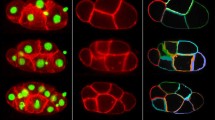Summary
Our earlier studies on embryonic arrest mutants of C. elegans had indicated that early deviations from the normal temporal and spatial pathway of development lead to monstrous terminal phenotypes with little resemblance to a hatched juvenile. To analyze more directly the roles of different parameters for cellular pattern formation, various experiments with a laser microbeam have now been performed and are described in this and the accompanying paper. By ablating early blastomeres we demonstrate here that the establishment of certain cell lineages is not necessary for the generation of a hatching juvenile. However, no replacement of missing cells was observed in these cases, and the resultant animals lacked those structures which are normally produced by the ablated cells. We found that retardation of cell cycle periods in certain cell lineages and thus a change in the normal order of cell divisions is compatible with development to a hatching juvenile. This is also true when, after irradiation of gut precursor cells, their inward migration is considerably delayed. Our results demonstrate that the invariant pattern of early nematode embryogenesis is not a necessary prerequisite for normal development. Studying parameters necessary for gastrulation we found that after irradiation leading to prolonged cell cycle periods the undivided gut founder cell itself rather than its two daughters moves into the center of the embryo. We removed individual early blastomeres and tested whether the typical inward movement of gut precursors still took place. Our results show that the presence of specific neighboring founder cells is not required, indicating that prospective gut cells reduce their cohesive contacts with adjacent blastomeres prior to the onset of gastrulation.
Similar content being viewed by others
References
Bourrillion A, Aubery M (1989) Cell surface glycoproteins in embryonic development. Int Rev Cytol 116:257–338
Boveri T (1899) Die Entwicklung von Asearis megalocephala mit besonderer Rücksicht auf die Kernverhältnisse. Festschrift Kupffer, Fischer, Jena 133–430
Boveri T (1910) Die Potenzen der Ascaris-Blastomeren bei abgeän-derter Furchung. Festschrift R. Hertwig, Fischer, Jena:133–214
Bowerman B, Eaton BA, Priess JR (1992) skn-1, a maternally expressed gene required to specify the fate of ventral blastomeres in the early C. elegans embryo. Cell 68:1061–1075
Brenner S (1974) The genetics of Caenorhabditis elegans. Genetics 77:71–94
Cooke J, Smith JC (1990) Measurement of developmental time by cells of early embryos. Cell 60:891–894
Denich KTR, Schierenberg E, Isnenghi E, Cassada R (1984) Cell-lineage and developmental defects of temperature-sensitive embryonic arrest mutants of the nematode Caenorhabditis elegans. Roux's Arch Dev Biol 193:164–179
Deppe U, Schierenberg E, von Ehrenstein G (1978) Cell lineages of the embryo of the nematode Caenorhabditis elegans. Proc Natl Acad Sci 75:376–380
Goldstein B (1992) Induction of gut in Caenorhabditis elegans embryos. Nature 357:255–257
Gurdon JB, Fairman S (1986) Muscle gene activation by induction and the nonrequirement for cell division. J Embryol Exp Morphol [Suppl] 97:75–84
Kemphues KJ, Priess JR, Morton DG, Cheng N (1988) Identification of genes required for cytoplasmic localization in early Caenorhabditis elegans embryos. Cell 52:311–320
Kobayakawa Y, Kubota HY (1981) Temporal pattern of cleavage and the onset of gastrulation in amphibian embryos developed from eggs with reduced cytoplasm. J Embryol Exp Morphol 62:83–94
Laufer JS, Bazzicalupo P, Wood WB (1980) Segregation of developmental potential in early embryos of Caenorhabditis elegans. Cell 19:569–577
Levi G, Duband JL, Thiery JP (1990) Modes of cell migration in the vertebrate embryo. Int Rev Cytol 123:201–252
Mello CC, Draper BW, Krause M, Weintraub H, Priess JR (1992) The pie-1 and mex-1 genes and maternal control of blastomere identity in early C. elegans embryos. Cell 70:163–176
Moritz KB (1967) Die Blastomerendifferenzierung für Soma und Keimbahn bei Parascaris equorum. Roux's Arch 159:203–266
Priess JR, Thomson JN (1987) Cellular interactions in early C. elegans embryos. Cell 48:241–250
Schierenberg E (1984) Altered cell division rates after laser-induced cell fusion in nematode embryos. Dev Biel 101:240–245
Schierenberg E (1987) Reversal of cellular polarity and early cell-cell interaction in the embryo of Caenorhabditis elegans. Dev Biol 122:452–463
Schierenberg E, Miwa J, von Ehrenstein G (1980) Cell lineages and development of temperature-sensitive embryonic arrest mutants in Caenorhabditis elegans. Dev Biol 76:141–159
Schierenberg E, Wood WB (1985) Control of cell-cycle timing in early embryos of Caenorhabditis elegans. Dev Biol 107:337–354
Schlicht P, Schierenberg E (1991) Altered establishment of cell lineages in the Caenorhabditis elegans embryo after suppression of the first cleavage supports a concentration-dependent decision mechanism. Roux's Arch Dev Biol 199:437–448
Schnabel R (1991) Cellular interactions involved in the determination of the early C. elegans embryo. Mech Dev 34:85–100
Skiba F, Schierenberg E (1992) Cell lineage, developmental timing, and spatial pattern formation in embryos of free-living soil nematodes. Dev Biol 151:597–610
Stephens L, Hardin J, Keller R, Wilt F (1986) The effects of Aphidicoline on morphogenesis and differentiation in the sea urchin embryo. Dev Biol 118:64–69
Stevens NM (1909) The effect of ultra-violet light upon the developing eggs of Asearis megalocephala. Arch Entw Mech 27:622–639
Sulston JE, Schierenberg E, White J, Thomson N (1983) The embryonic cells lineages of the nematode Caenorhabditis elegans. Dev Biol 100:64–119
Wood WB (1988) The nematode Caenorhabditis elegans. Cold Spring Harbor Laboratory, Cold Spring Harbor
Wood WB (1991) Evidence from reversal of handedness in C. elegans embryos for early cell interactions determining cell fates. Nature 349:536–538
zur Strassen O (1896) Embryonalentwicklung der Ascaris megalocephala. Arch Entw Mech 3:27–105, 133–190
zur Strassen O (1959) Neue Beiträge zur Entwicklungsmechanik der Nematoden. Zoologica 107:1–142
Author information
Authors and Affiliations
Additional information
Correspondence to: E. Schierenberg
Rights and permissions
About this article
Cite this article
Junkersdorf, B., Schierenberg, E. Embryogenesis in C. elegans after elimination of individual blastomeres or induced alteration of the cell division order. Roux's Arch Dev Biol 202, 17–22 (1992). https://doi.org/10.1007/BF00364593
Received:
Accepted:
Issue Date:
DOI: https://doi.org/10.1007/BF00364593




